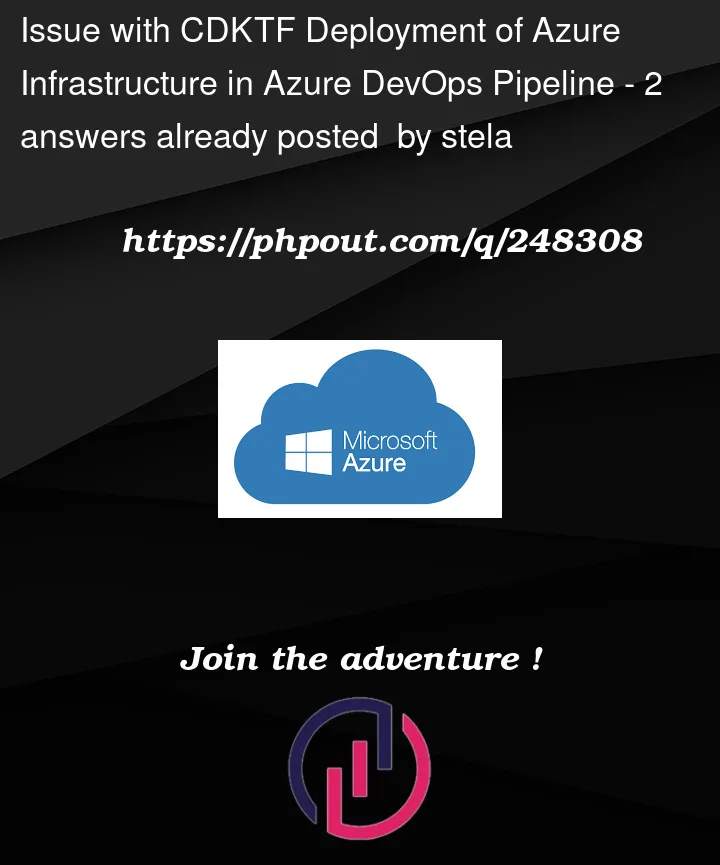I’m encountering an issue while trying to deploy Azure infrastructure using CDKTF (azurerm provider) within an Azure DevOps pipeline. Here’s a simplified version of the code I’m using:
//code setup...
class MyStack extends TerraformStack {
constructor(scope: Construct, id: string, env: Environment) {
super(scope, id);
// Azure provider setup and backend configuration...
const resGroup = new ResourceGroup(this, env.CreateId(resourceGroupId), {
// Resource group configuration...
});
const mainStorageAccount = new StorageAccount(this, env.CreateId(storageAccountId), {
// Storage account configuration...
});
const cdnProfile = new CdnProfile(this, env.CreateId(profileNameId), {
// CDN profile configuration...
});
const cdnEndpointConfig = {
// CDN endpoint configuration...
};
new CdnEndpoint(this, cdnEndpointConfig.name, cdnEndpointConfig);
}
}
// App setup and environment variables...
const app = new App();
const tfEnvironmentType = process.env.TF_ENVIRONMENT || 'test';
const market = process.env.MARKET || 'A';
let env: Environment | undefined;
if (tfEnvironmentType && market) {
env = new Environment(tfEnvironmentType, market);
} else {
console.error('One or more environment variables are missing.');
process.exit(1); // Exit the process with a non-zero status code to indicate an error
}
if (env) {
const environmentID = env.GetID();
new MyStack(app, 'src', env);
app.synth();
}Azure DevOps pipeline task for deploying with Market A:
- task: AzureCLI@2
displayName: Running Deployment with Market XX
inputs:
azureSubscription: $(AZURE_SUBSCRIPTION)
scriptType: 'bash'
scriptLocation: 'inlineScript'
addSpnToEnvironment: true
failOnStandardError: true
inlineScript: |
cd infrastructure
export ARM_CLIENT_ID=$servicePrincipalId
export ARM_CLIENT_SECRET=$servicePrincipalKey
export ARM_TENANT_ID=$tenantId
export ARM_SUBSCRIPTION_ID=$AZURE_SUBSCRIPTION_ID
export MARKET=A # Set Market variable to 'A'
echo "Deploying infrastructure with Market: $MARKET"
npm run deployAzure DevOps pipeline task for deploying with Market B:
- task: AzureCLI@2
displayName: Running Deployment with Market DK
inputs:
azureSubscription: $(AZURE_SUBSCRIPTION)
scriptType: 'bash'
scriptLocation: 'inlineScript'
addSpnToEnvironment: true
failOnStandardError: true
inlineScript: |
cd infrastructure
export ARM_CLIENT_ID=$servicePrincipalId
export ARM_CLIENT_SECRET=$servicePrincipalKey
export ARM_TENANT_ID=$tenantId
export ARM_SUBSCRIPTION_ID=$AZURE_SUBSCRIPTION_ID
export MARKET=B # Set Market variable to 'B'
echo "Deploying infrastructure with Market: $MARKET"
npm run deploypackage.json
"scripts": {
"deploy": "cdktf deploy $npm_config_TF_ENVIRONMENT --auto-approve",
// Other scripts...
}I’ve noticed that deploying the infrastructure for Market B is causing the resources created for Market A to be destroyed. How can I deploy resources for both Market A and B without interfering with each other? Any help in successfully deploying Azure infrastructure using CDKTF within an Azure DevOps pipeline for different markets would be greatly appreciated.
Update:
Thanks @Martin, Besides using separate tfstate files, I found a fix by using different output parameters in my deployment:
Here’s how I set it up:
"deploy:A": "MARKET=A cdktf deploy $npm_config_TF_ENVIRONMENT --auto-approve --output=cdktf.out.A",
"deploy:B": "MARKET=B cdktf deploy $npm_config_TF_ENVIRONMENT --auto-approve --output=cdktf.out.B"So, with these commands:
deploy:A for the "A" market.
deploy:B for the "B" market.
This trick allowed me to customize the deployment process as needed. Just sharing this in case it helps someone else out!
Cheers,




2
Answers
I only have experience with AWS cdktf but I think you are missing defining separated state files like for each stack. like:
Have you tried to change the name of the stack according to the environment?
vs
and
The out folder should now build 2 stacks. Just concat the name dynamically, based on your input of which market you build to.
Did this is AWS CDK that way. Not sure if it transfers to cdktf